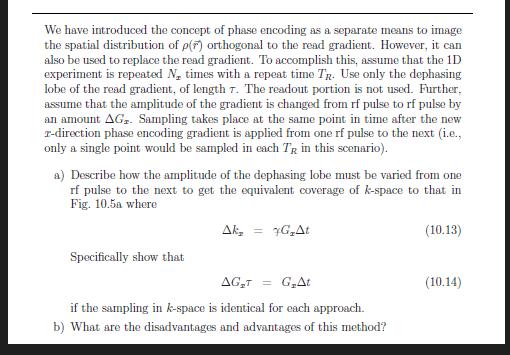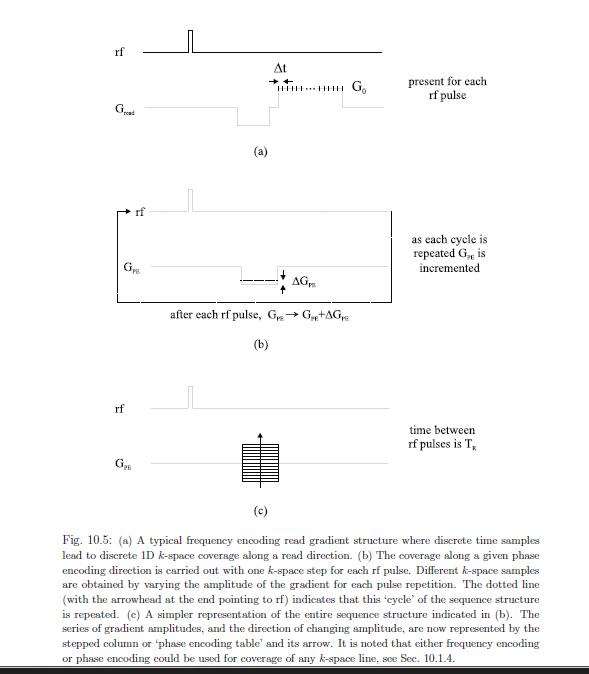Answered step by step
Verified Expert Solution
Question
1 Approved Answer
We have introduced the concept of phase encoding as a separate means to image the spatial distribution of p(r) orthogonal to the read gradient.


We have introduced the concept of phase encoding as a separate means to image the spatial distribution of p(r) orthogonal to the read gradient. However, it can also be used to replace the read gradient. To accomplish this, assume that the 1D experiment is repeated N, times with a repeat time TR. Use only the dephasing lobe of the read gradient, of length 7. The readout portion is not used. Further. assume that the amplitude of the gradient is changed from rf pulse to rf pulse by an amount AG. Sampling takes place at the same point in time after the new r-direction phase encoding gradient is applied from one rf pulse to the next (i.e., only a single point would be sampled in each TR in this scenario). a) Describe how the amplitude of the dephasing lobe must be varied from one rf pulse to the next to get the equivalent coverage of k-space to that in Fig. 10.5a where Specifically show that Ak = GAt AGT = GAt if the sampling in k-space is identical for each approach. b) What are the disadvantages and advantages of this method? (10.13) (10.14) rf rf rf Gre (a) At + HHHHH G AG after each rf pulse, G G+AG (b) present for each rf pulse as each cycle is repeated Gis incremented time between rf pulses is T, (c) Fig. 10.5: (a) A typical frequency encoding read gradient structure where discrete time samples lead to discrete ID k-space coverage along a read direction. (b) The coverage along a given phase encoding direction is carried out with one k-space step for each rf pulse. Different k-space samples are obtained by varying the amplitude of the gradient for each pulse repetition. The dotted line (with the arrowhead at the end pointing to rf) indicates that this 'cycle' of the sequence structure is repeated. (c) A simpler representation of the entire sequence structure indicated in (b). The series of gradient amplitudes, and the direction of changing amplitude, are now represented by the stepped column or 'phase encoding table and its arrow. It is noted that either frequency encoding or phase encoding could be used for coverage of any k-space line, see Sec. 10.1.4.
Step by Step Solution
★★★★★
3.48 Rating (155 Votes )
There are 3 Steps involved in it
Step: 1
a In the traditional method of phase encoding the read gradient is used to encode the spatial inform...
Get Instant Access to Expert-Tailored Solutions
See step-by-step solutions with expert insights and AI powered tools for academic success
Step: 2

Step: 3

Ace Your Homework with AI
Get the answers you need in no time with our AI-driven, step-by-step assistance
Get Started


